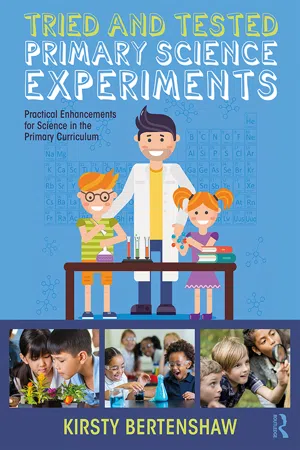
Tried and Tested Primary Science Experiments
Practical Enhancements for Science in the Primary Curriculum
- 128 pages
- English
- ePUB (mobile friendly)
- Available on iOS & Android
Tried and Tested Primary Science Experiments
Practical Enhancements for Science in the Primary Curriculum
About This Book
The modern world needs more scientists and engineers, and good science education is key to filling this gap. Especially in the current climate of rapid curriculum changes, a lack of emphasis on training can result in unconfident teaching and monotonous lessons. To rectify this, this book offers methods to deliver the National Curriculum aims at primary school in an interesting, hands-on and fun fashion.
Tried and Tested Primary Science Experiments provides a practical step-by-step guide for all year groups, helping teachers to create more engaging and fun science lessons in the classroom. All experiments are simple to follow, fail-safe and are designed to enthuse and inspire students. It includes:
-
- tried and tested guides to running successful science experiments;
-
- clear instructions that outline the simple equipment required, how to carry out the experiments and what results to expect;
-
- suggestions for adapting each activity to the special needs and interests of the students.
Aimed at primary school teachers and trainee teachers, this illustrated guide refers directly to the new curriculum and is an essential resource for every primary classroom.
Frequently asked questions
Information
Year 1 Plants
National Curriculum Statements:
Working scientifically:
NC Assessment Indicators
GROWING PLANTS
Equipment:
Instructions:
Health and safety
| Hazard and risk | Precautions |
| Seeds can pose a choking hazard and can be toxic. | Use under supervision. Do not allow students to ingest seeds. |
| Plastic pots, Petri dishes and plant pots can break and cause cuts. | Check for chips and damage before using. Discard any damaged objects. |
| Soil can contain microbes and parasites. | Adult supervision required, hands must be washed well with soap after activity. Do not allow students to ingest soil. |
| Cotton wool is a suffocation and choking hazard. | Adult supervision required, do not allow students to place cotton wool over their faces or ingest it. |
| Water spillages can be a slipping hazard. | Clear any spilt water immediately. |
Adapting the activity
SEASONS
Equipment:
Instructions:
Adapting the activity
CLASSIFICATION OF TREES
Equipment:
Instructions:
Version 1
Version 2
Version 3
Health and safety
| Hazard and risk | Precautions |
| Plants can contain toxins, thorns or spikes. | Adult supervision required. |
| Allergies to plants and insect bites. | Check allergies of students before commencing activity. Be aware of insect activity in the school area – avoid ... |
Table of contents
- Cover
- Half Title
- Title Page
- Copyright Page
- Table of Contents
- Preface
- Year 1 Plants
- Year 1 Animals including humans
- Year 1 Materials
- Year 1 Seasonal changes
- Year 2 Living things and their habitats
- Year 2 Plants
- Year 2 Animals including humans
- Year 2 Uses of everyday materials
- Year 3 Plants
- Year 3 Animals including humans
- Year 3 Rocks
- Year 3 Light
- Year 3 Forces and magnets
- Year 4 Living things and their habitats
- Year 4 Animals including humans
- Year 4 States of matter
- Year 4 Sound
- Year 4 Electricity
- Year 5 Living things and their habitats
- Year 5 Animals including humans
- Year 5 Properties and changes of materials
- Year 5 Earth and space
- Year 5 Forces
- Year 6 Living things and their habitats
- Year 6 Animals including humans
- Year 6 Evolution and inheritance
- Year 6 Light
- Year 6 Electricity
- Index